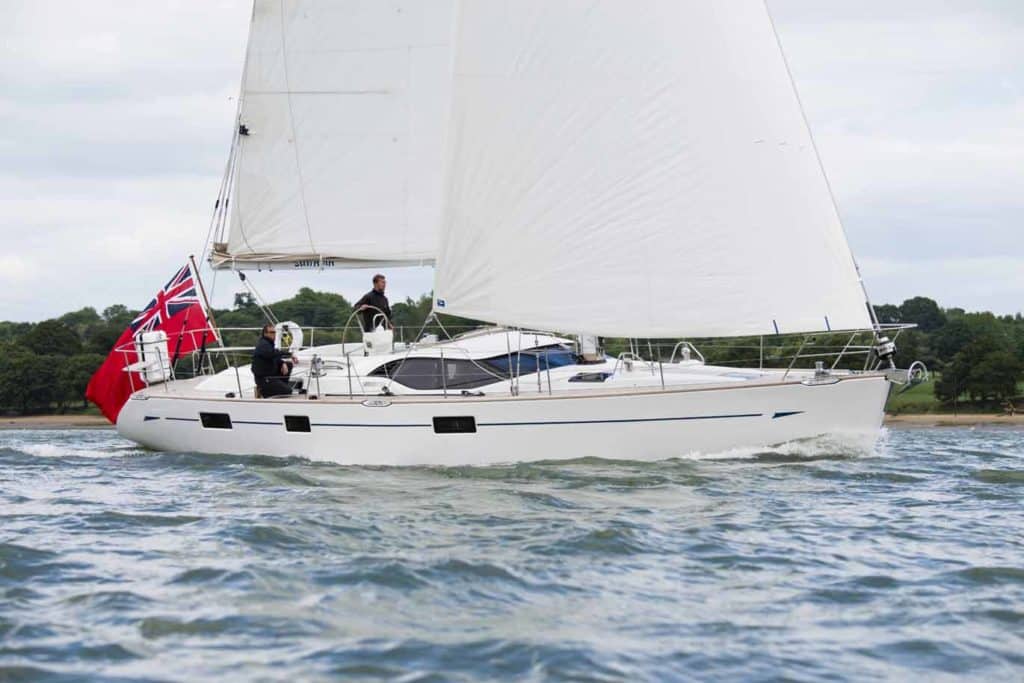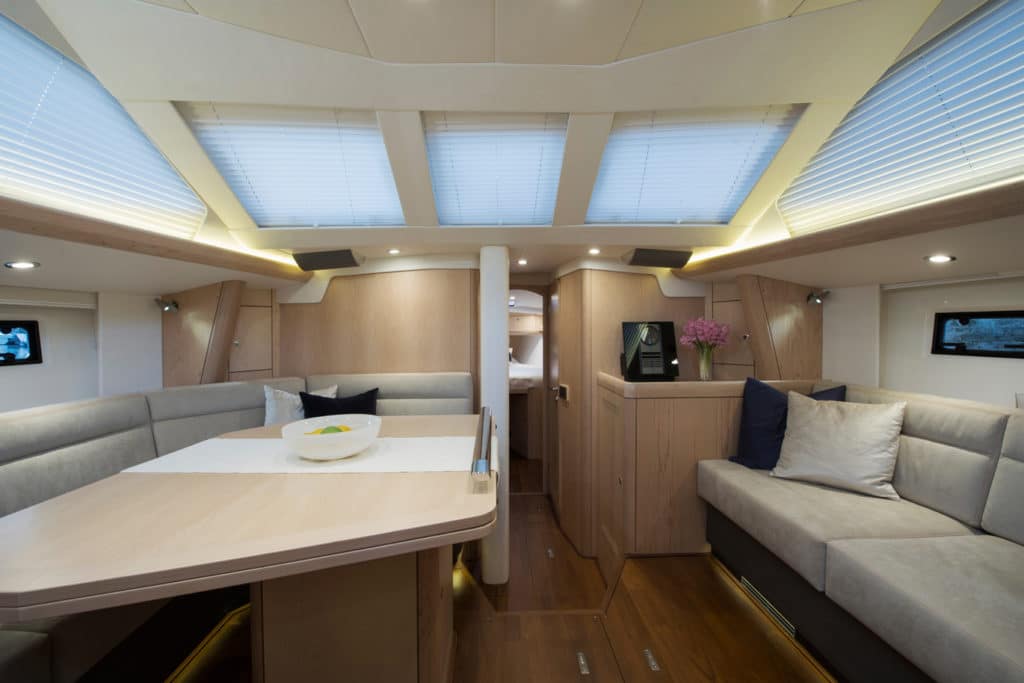
For boatbuilders, the own-ers rendezvous has become a key selling venue. Owners share camaraderie, adventure, and competition, but more important for the builders, the attendees get firsthand exposure to recent-and, the builders hope, bigger-versions of the brand these captive clients love. Such events can carry risk, though. Animated discussions over dinner can lead to exchanges about performance or execution shortfalls, or-worse still for the builders-owners sharing stories of how they beat down the price of equipment.
Britain’s Oyster Marine joined the rendezvous game five years ago and has enjoyed considerable success gathering owners for casual racing, golf, and bread breaking in popular cruising locales around the world. The 2006 Montpelier Oyster Regatta last summer in Cowes, on the Isle of Wight, provided plenty of what Oyster and the owners attending had hoped for: good racing, good social events, and good boat chat. For many, including me, the event provided a first look at the new Oyster 46, which was introduced at the 2005 London Boat Show and was due to make landfall in the U.S. at the 2006 U.S. Boat Show in Annapolis, Maryland. I had the opportunity to steer the boat in a good breeze for much of a 23-mile race in the Solent and found it nimble, easily managed shorthanded, and in step with Oyster’s reputation for building premium, well-found, semicustom cruising boats.
The 46 replaces the stalwart Oyster 45 as the “entry-level” model in the line, which currently extends up to 82 feet. The 46 is faster, more spacious belowdecks, and, with Oyster’s new styling scheme, prettier than its predecessor.
“There are major changes in several areas over the 45,” says Oyster chairman Richard Matthews of the new 46. “First is the new G5 styling.”
G5 denotes the fifth generation of Oyster deck-saloon boats. The signature element is the profile view of the deck saloon, which emphasizes double curves and contours over the boxier look of years past. The 46 and the recently launched Oyster 655 and 72 were designed from the ground up with those elements in place. The decks on the rest of the line have been redesigned and retooled to reflect the changes.
“The hull has also been updated with more beam, especially aft, a longer waterline, and a fully optimized keel with a low center of gravity,” says Matthews.
Although he builds boats primarily intended for cruising, Matthews is an inveterate racer, and while few would mistake an Oyster for a grand-prix product, improving the performance specifications on the boats is an ongoing concern. Oyster performance-enhancing duties have fallen on designer Rob Humphreys in recent years. Humphreys, who’s designed a number of notable raceboats, including Ellen MacArthur’s Open 60 Kingfisher, and the Oyster design team have created a hull shape they say provides a marked improvement in speed and stability over the 45, while also accommodating 15 percent more interior volume.
The 46 carries 2 feet 7 inches more waterline length than the 45, 6 inches more beam, 3,600 pounds more displacement, and 186 square feet more sail area. Humphreys, who was primarily responsible for the boat’s lines, gave it a modern shape with a fine entry and flatter sections aft. His intention was to provide speed and stability while accommodating the three-stateroom plan and owners’ load-carrying needs. Humphreys says the keel, a filleted bulb, is an evolution of many of the cruising keels he’s done for Oyster and others. The rudder is skeg-hung.
“The 46 is powerful, but stands to the sails like a bigger boat,” says Humphreys.
During the race on the Solent last summer, I found the 46 to be-dare I say of a cruising boat?-exhilarating to sail. The breeze was southwest at about 14 knots; the sky was layered in gray and white with intermittent showers about. I was aboard Solway Mist, which Oyster delivered to owner John Maxwell during the regatta. Maxwell was generous enough to concede the wheel to me for nearly half the race.
The Solent is a labyrinth of fast, tricky currents, and the zigzag course to the west of Cowes had us on every point of sail working the tide at every possible angle. The first leg was down current. I found the boat to be exceptionally stiff and weatherly, able to hold speeds of 6.5 to 7 knots with an apparent-wind angle of about 40 degrees. I expected to get wet, but with the boat’s generous freeboard, the only hosing we got was from the rain showers. While the decks weren’t slippery, the hull certainly was. By the first weather mark, we’d dusted most of the competition in our class.
Oyster offers an in-mast furling main, but Solway Mist was equipped with a fully battened main, roller-furling genoa, and asymmetric spinnaker. With some effort, we were able to carry the asymmetric on a short close-reaching leg, which produced the highest speeds of the afternoon. We sailed most of the leg at speeds above 8.5 knots. Solway Mist has the standard 7-foot-1-inch deep keel, which certainly contributed to the boat’s strong upwind performance; a shoal-draft model, with a draft of 5 feet 9 inches, is also available.
Maxwell’s previous yacht was an Oyster 56, which he says was a bit much for his wife and him to handle without crew. The 46 is a three-cabin, two-head boat, which Maxwell says is ideal for his intended uses, which he hopes will include some long-term cruising and passagemaking. The deck layout and the sailhandling systems are designed with a cruising couple in mind. The halyards, reefing lines, outhaul, topping lift-and mainsheet, if the owner chooses to have it there-lead under the coachroof to stoppers under the spray hood. Maxwell’s setup included electric primary and mainsheet winches, with the mainsheet just outside the cockpit coaming within easy reach of the helm. Bulwarks with teak caprails and uncluttered decks contribute safety and security to the package.
The center-cockpit arrangement Oyster uses provides friendly on-deck entertaining space and, while at sea, good visibility. Oyster says the 46 has 15 percent more cockpit space than the 45, due in part to the additional beam. Maxwell specified a Whitlock collapsible wheel that permits full walk-around access when the boat’s not under way. In addition to a solid complement of communications gear, Maxwell had his helm and nav station set up with Raymarine’s E80 multifunction system. The system, with a secondary display at the helm, provides full charting information, including current direction and velocity relative to our course, which proved particularly useful in the Solent during the regatta.

The interior on the 46 is first-class, as you might expect from a boat in the $1 million price range. The joinery is substantial, well-fitted, and finished to a high level. Maxwell’s interior is teak. I’m a fan, but Oyster also offers lighter finishes, such as cherry and white oak.
Oyster’s widely emulated deck-saloon configuration contributes light and airy headroom below. The broad forward windows, which are larger than those on the 45, open to provide significant ventilation and draw in light. A burled-maple-veneered table folds across the saloon to accommodate dining for six or seven.
Tanks, batteries, and mechanicals are positioned beneath the raised-saloon sole. The tanks are molded into the hull and serve as structural elements while keeping weight near the boat’s center of gravity.
The standard arrangement has a well-setup galley to port and a forward-facing nav station to starboard at the base of the companionway, each with separate access to the master stateroom. The center cockpit allows maximum headroom in the master-a feature that will appeal to anyone who plans to stay aboard for extended periods. The master’s en-suite head has a space-saving aft-facing toilet that’s centered in the enclosure. Given the capacious proportions of the other interior spaces though, the curtained shower stall feels a bit like a Star Trek transporter tube. Owners with large girths won’t appreciate the cold curtain sticking to them while they’re getting ready for an evening ashore.
The midships cabin has bunks, but it might serve better as a workshop for long-haulers. While not nearly as spacious as the master, the forward cabin is comfortable and well-equipped with gear and clothing stowage. The two cabins share a comfortable head with shower.
Oyster builds its hulls of tried-and-true FRP, but with recent designs the company has used a laminate employing vinylester, polyester, and blended resins. The only cored parts of the boat are the deck and other horizontal elements.
The standard engine is a 75-horsepower Volvo diesel mated to a saildrive. Oyster will do a straight shaft if an owner prefers. According to the company, the boat will cruise at about 8 knots under power.
The tweaks that have contributed to the increased interior volume and improved sailing performance are far less dramatic than the latest styling elements, instituted first on the recent Oyster 72. Matthews once described the overlapping curves, tapered side windows, and lower profile of the latest generation of deck-saloon superstructure as “horny.” The look does evoke lusty metaphors. Cowes-regatta attendees used terms such as “sexy” and “kinky” to describe the look of the 46. However you see it, the new design does manage to make the traditional, inherently boxy center-cockpit/deck-saloon profile look downright dowdy. Once upon a time, customers for boats like this were older men who’d sold a business and were off to live the dream. Oyster acknowledges that success is coming earlier in life to many and that the average age of its customers is dropping. The sex appeal of this boat is a direct shot at that demographic.
For Oyster and its owners, the Cowes regatta had the desired effect. Sir Nigel Southward, vice commodore of the Royal Yacht Squadron, and his wife were on board Solway Mist for the race in the Solent. His new 46 is due to be delivered in April. As with many at the regatta, he could be seen in a huddle with other Oyster owners discussing specs and performance. The rendezvous was an eye-opener and validated his purchase-and probably delighted Oyster, too.
“It makes me really quite happy to be on this boat knowing what I’ve done,” says Southward of his purchase after his outing on the water. “But I fear I’ve spent a lot of money today.”
Oyster 46 Specs
LOA: 46′ 10″ (14.26 m.)
LWL: 40′ 7″ (12.36 m.)
Beam: 14′ 6″ (4.41 m.)
Draft (standard/shoal): 7′ 1″/5′ 9″ (2.16/1.75 m.)
Sail Area: 1,317 sq. ft. (122.3 sq. m.) (150-percent foretriangle)
Ballast: 11,900 lb. (5,400 kg.)
Displacement: 38,580 lb. (17,500 kg.)
Ballast/D: 0.31
D/L: 228
SA/D: 18.09
Water: 172 gal. (650 l.)
Fuel: 198 gal. (750 l.)
Height of masthead: 62′ 5″ (19.03 m.) Including antennas: 65′ 11″ (20.1 m.)
Engine: 75-hp. Volvo with saildrive
Designer: Rob Humphreys with Oyster Design Team
Price: $1,150,000 (delivered to Newport, R. I.)
Oyster Marine USA, www.oystermarine.com, (401) 846-7400
Formerly a CW editor at large and the editor in chief of Yachting, Kenny Wooton recently became executive editor of ShowBoats International.








